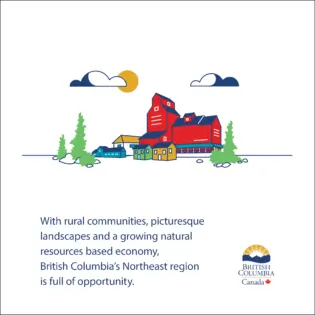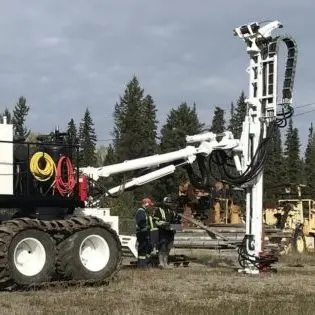Northeast, British Columbia
This region is bordered by the Yukon and Northwest Territories in the north, the Rocky Mountains to the west and Alberta to the east. It is a vast and remote area of mountains, foothills, forests, lakes, and the Peace River valley. Affordable housing and unlimited recreational opportunities attract and retain an active and exciting community of entrepreneurs, tradespeople, clean energy, and resource professionals.
The Northeast region holds the province’s highest rate of employment and has a high demand for skilled and level entry workers. The Northeast’s economy is based on natural resources, particularly natural gas production, agriculture, forestry, and critical minerals. Rapid development of the energy sector contributes to the Northeast region’s growth. Power-generating projects, planned and in progress, include hydroelectric dams and wind farms.

Regional Advantages

MILE ZERO CITY
The 2,000km stretch, from Dawson Creek to Alaska, services the communities and critical minerals operations in the northern region of the province, as well as Alberta, Yukon, Northwest Territories and the state of Alaska.

LOW COST & HIGH STANDARD OF LIVING
Families in Fort St. John have the highest average household income in B.C. and the fifth highest in all of Canada.

THE ENERGETIC CITY
The largest city in B.C. along the Alaska Highway, Fort St. John, is called The Energetic City due to its wealth resources, as well as a younger population than the rest of the province.

NORTHERN INDUSTRIES INNOVATION FUND
Provides funding for SME’s in eligible industries for applied research and development, new or improved products, and services and testing of innovative technologies.
Key Sectors

Agrifood, Seafood
& Food Processing

Clean Energy

Critical
Minerals

Agri Tech
Fort St. John
Fort St. John is “The Energetic City”, which reflects not only our large resource base of oil, natural gas, forestry and agriculture, but also the vitality of our residents who are keen to live and work in a community that gives back so much. Fort St. John attracts travelers with its wilderness adventures, as well as being home to some of the best hunting and fishing opportunities in North America and is often referred to as “The Serengeti of the North”. Not to mention, people from near and far come to travel the world’s renowned and scenic Alaska Highway.
Dawson Creek
Dawson Creek is located in The Boreal Plains Ecozone. It is part of the flat Interior Plains of Canada, a northern extension of the Great Plains of North America. The Peace Lowland ecoregion is characterized by a unique climate, marked by warmer summers than the surrounding areas. The mean annual temperature is 0.5°C. The mean summer temperature is 13°C and the mean winter temperature is -14°C. The mean annual precipitation ranges from 350–600 mm.
Communities
The Northeast has a population of 72,300 people. Main population centres such as Fort St. John and Dawson Creek and smaller communities such as Chetwynd, Tumbler Ridge, Fort Nelson, Pouce Coupe and Taylor all contribute to the region’s growing natural resource-based economy.
Discover more facts and statistics about this region:
Regional Economic ProfileEconomic Development Organizations
First Nations
The Northeastern economy is based on natural resources, particularly natural gas production and coal mining. Other important industries include logging, wood products manufacturing and agriculture.
Development corporations— owned collectively by aligned First Nations or by individual First Nations— are the primary vehicles by which First Nations pursue and advocate for sustainable economic development in the region.
Learn more about First Nations in BCEconomic Development Organizations
Regional Profile
Educational Institutions

The University of Northern British Columbia (UNBC) is a research-intensive public university with a campus in Fort St. John.

Northern Lights College empowers and enhances the local workforce through a wide range of professional programs, including business management, oil and gas field operations, and trades.
Connect With A Regional Expert
Regional experts can help familiarize you with the amenities, infrastructure, and opportunities in each region. They can introduce you to the economic development offices and industry associations that will support the integration of your business into the province.

